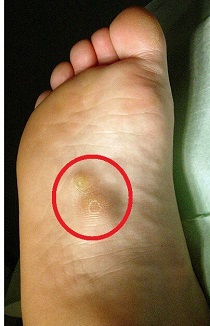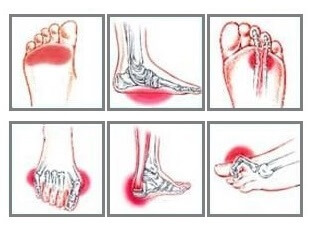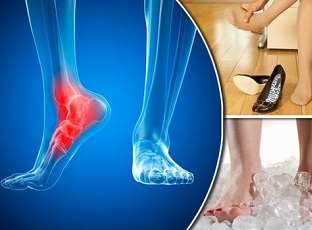- Home
- Common Foot Problems
- Plantar Fibromatosis
Plantar Fibromatosis
Written By: Chloe Wilson BSc(Hons) Physiotherapy
Reviewed By: FPE Medical Review Board
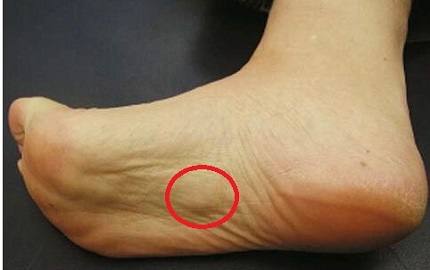
Plantar Fibromatosis is a foot condition where a small nodule, a plantar fibroma, grows in the arch of the foot on the plantar fascia.
A plantar fibroma is a benign growth i.e. non-cancerous, which tends to be slow growing and usually less than an inch in size.
Plantar fibromatosis is often painless but, depending on the location and size of the nodules, it can start to cause foot arch pain when you are on your feet.
Other medical terms for plantar fibromatosis include Ledderhose Disease, after Georg Ledderhose who first identified the disease in 1894, Morbus Ledderhose and Plantar Fascial Fibromatosis. It is a similar condition to Dupytren’s contracture which occurs in the hand causing flexion of the fingers.
What Is Plantar Fibromatosis?
In plantar fibromatosis, thickenings develop in the plantar fascia, the thick band of fibrous tissue on the bottom of the foot.
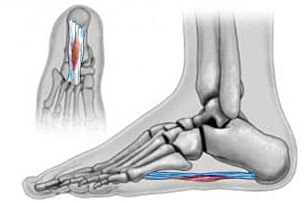
The plantar fascia runs between the heel and the toes, helping to support the arches of the foot.
The thickenings in the plantar fascia can end up forming small nodules, plantar fibromas, usually in the central or medial portions of the plantar fascia. There may be one solitary nodule or a cluster of nodules may develop. Plantar fibromas are one of the most common causes of a lump on bottom of foot.
Ledderhose Disease is a relatively minor condition but can cause foot arch pain with weight bearing activities such as standing and walking. Plantar fibromatosis usually only affects one foot, but in 25% of cases, both feet are affected. It should not be confused with plantar fasciitis where there is inflammation and degeneration of the plantar fascia.
Plantar Fibromatosis Symptoms
Common symptoms of Ledderhose Disease include:
- Visible Nodule: The most common symptom of plantar fibromatosis is a small lump under the skin on the sole of the foot. These nodules tend to be on the inner side of the sole of the foot, at the highest point of the foot arch.
- Foot Pain: Often plantar fascial fibromatosis is entirely painless, but as the lump grows it may start to cause problems. Foot pain from plantar fibromatosis tends to occur when there is pressure directly on the plantar fibroma nodule, either from prodding it, pressure from shoes or weight bearing through the foot when standing, walking or running
- Toe Stiffness: As plantar fibromatosis progresses, it can cause thickening of the plantar fascia. This can result in contractures and tightness which cause the toes to bend, limiting toe movements, causing stiffness and making walking difficult.
Plantar fibroma nodules are usually small in size, typically measuring less than one inch and feel firm to touch. They may remain the same size, grow over time or more nodules may gradually appear forming a cluster. They are one of the most common causes of a bump on the bottom of the foot.
The nodules can most easily be seen by dorsiflexing the foot – pulling the toes up. The plantar fibroma growths remain permanently unless removed surgically, they don’t just spontaneously resolve.
Plantar fibromatosis may go undetected for years if it is not causing any pain.
What Causes Ledderhose Disease?
The underlying cause of plantar fibromatosis is unknown but there are a number of factors which are thought to be linked with Ledderhose disease:
- Genetics: A family history of Ledderhose Disease or Dupuytren's Contracture in the hands are the strongest risk factor for developing plantar fibromatosis
- Gender: Plantar Fibromatosis is more common in men then women with a male:female ratio of 2:1
- Medical Conditions: Diabetes, epilepsy, liver disease and Peyronie’s disease are thought to be associated with increased risk of developing plantar fibroma
- Long-term Alcohol Consumption: is thought to increase the risk of developing Ledderhose Disease
- Repetitive Foot Trauma: it is thought that plantar fibromatosis may develop as a result of small tears in the plantar fascia. As the body tries to heal itself, it goes into overdrive, laying down too much new tissue which forms the nodules
Diagnosing Ledderhose Disease
Your doctor may be able to diagnose plantar fibromatosis through clinical examination.
If there is any doubt, an MRI scan (Magnetic Resonance Imaging) is usually the imaging of choice as there are other conditions than cause a bump under the foot or present in a similar fashion, such as plantar fasciitis.
MRI tends to be more accurate than x-ray or ultrasound at diagnosing plantar fibromatosis, showing the full extent of the condition.
Treating Plantar Fibromatosis
Plantar fibromatosis treatment usually involves a combination of the following:
1. Observation
Asymptomatic nodules, i.e. those that aren’t causing any pain, will most likely just be monitored. The nodules will never disappear, but they may never cause any problems.
2. Injections
Corticosteroid injections can help relieve the pain and are most effective in the early stages of plantar fibromatosis and when given under ultrasound guidance.
3. Orthotics
Wearing shoe insoles or special padding can help to reduce the force through plantar fibroma nodules, making walking more comfortable.
4. Physiotherapy
Treatment such as exercises, ultrasound and shock wave therapy may help reduce plantar fibromatosis pain.
5. Radiotherapy
If the plantar fibroma nodule is growing and active then radiotherapy can be used to shrink and soften the lump. Whilst it won't get rid of the plantar fibroma completely, it may help delay progression for a number of years
6. Surgery
Surgery for plantar fibromatosis should only be considered when there have been prolonged high pain levels and resultant decreased activity levels over a number of months.
You can find out loads more about each of these treatment options including the pros and cons of each in the Plantar Fibroma Treatment article.
Your Questions Answered
- Can A Plantar Fibroma Go Away? Without treatment a plantar fibroma is unlikely to get smaller or go away. The symptoms of plantar fibromatosis will settle with treatment, but the fibroma itself will remain unless surgically removed.
- Is Plantar Fibromatosis Cancerous? No, a plantar fibroma is not cancerous. It is simply a mass of fibrous tissue in the foot which is completely benign i.e. non-malignant.
- Is Plantar Fibromatosis The Same Thing As Plantar Fasciitis? No, fibromatosis and fasciitis are different conditions. Plantar fibromatosis is when a nodule grows in part of the plantar fascia. Plantar fasciitis is when there is damage and inflammation to the plantar fascia.
- Is Ledderhose Disease Painful? Some people with Ledderhose disease do not get any pain at all, and may be completely unaware of the plantar fibroma. As the fibroma grows however, it may start pushing on surrounding tissues and causing pain when there is any pressure through the foot.
- How Common Is Plantar Fibromatosis? Plantar Fibromatosis is a relatively rare disease which affects less than 1% of the population. This figure however rises to around 25% in people over the age of 65. Ledderhose Disease is 10 times more in common in men than women.
- How Do You Stretch A Plantar Fibroma? You cannot stretch a plantar fibroma directly, but you can stretch the plantar fascia which it sits in. Rolling a golf ball or can underneath your foot is a great way to stretch out the area. Visit the plantar fascia stretches section to find out loads more.
- What Is The Plantar Fibromatosis ICD 10 Code? The 2021 icd 10 code for plantar fibromatosis is M72.2.
- What Else Could It Be? There are lots of other things that can cause a lump underneath the foot other than plantar fibromas e.g. Morton's Neuroma, plantar warts and piezogenic papules - you can find out all about the in the Bottom Of Foot Lumps section.
What Else Can Help
You can find out loads more about the different treatment and prevention options in the Treatment For Plantar Fibroma article.
There are a number of other conditions that can cause pain in the bottom of the foot. If plantar fibromatosis isn’t sounding quite like your problem, visit the foot arch pain page in the diagnosis section for help working out what may be causing your problem.
You may also be interested in the following articles:
- Foot Lumps & Bumps
- Pain On Top Of Foot
- Foot Arch Pain
- Nerve Pain In The Foot
- Foot & Ankle Stretches
- Swollen Feet & Ankles
- Foot Numbness
Page Last Updated: 11/22/23
Next Review Due: 11/22/25
Related Articles
Common Symptoms
January 27, 2023
Diagnosis Chart
November 2, 2023
Foot Pain Treatment
September 18, 2022
References
1. The Journal of Clinical and Aesthetic Dermatology - Ledderhose Disease: An Unusual Presentation. D. Fausto de Souza, L. Micaelo, T. Cuzzi and M. Ramos-e-Silva. September 2010
2. American Journal of Surgery - Incidence and treatment of recurrent plantar fibromatosis by surgery and postoperative radiotherapy. de Bree E, Zoetmulder F, Keus R, Peterse H and van Coevorden F. January 2004
3. Foot & Ankle Specialist Journal - Plantar Fibromatosis: Pathophysiology, Surgical and Nonsurgical Therapies: An Evidence-Based Review. Carroll P, Henshaw R, Garwood C, Raspovic K, Kumar D
